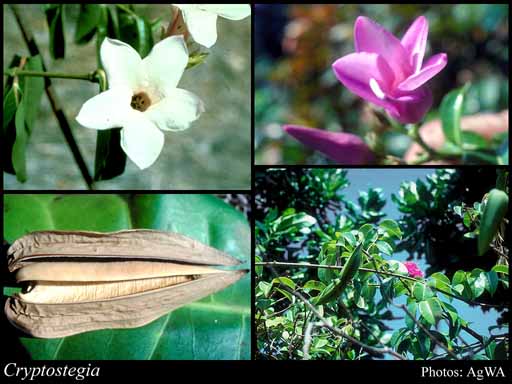- Reference
- Edwards's Bot.Reg. 5:435 (1820)
- Name Status
- Current

Scientific Description
Family Asclepiadaceae.
Sometimes included in Apocynaceae. Sometimes referred to Family Periplocaceae, which is sometimes treated as Family Asclepiadaceae Subfamily Periplocoideae, Tribe Periploceae.
Habit and leaf form. Lianas, or shrubs; laticiferous (with white latex). ‘Normal’ plants. Plants with roots (fibrous). Leaves cauline. Young stems cylindrical. Climbing. Mesophytic. Leaves medium-sized; not fasciculate; opposite; not decurrent on the stems; leathery; not imbricate; petiolate. Petioles wingless. Leaves simple; epulvinate. Leaf blades dorsiventral; entire; flat; elliptic; pinnately veined; cross-venulate; truncate or cuneate at the base. Leaf blade margins entire; flat.
Reproductive type, pollination. Fertile flowers hermaphrodite. Unisexual flowers absent. Plants hermaphrodite. Plants homostylous.
Inflorescence and flower features. Flowers aggregated in ‘inflorescences’; in umbels (‘fascicles’). Inflorescences simple; axillary. Flowers pedicellate; large; regular; 5 merous; cyclic; tetracyclic. Free hypanthium absent. Hypogynous disk absent. Perianth with distinct calyx and corolla; 10; 2 -whorled; isomerous. Calyx present; 5; 1 -whorled. Corolla present; 5; 1 -whorled; appendiculate (with a corolline corona of 5 filaments attached in corolla tube); gamopetalous; lobed; lobulate. Corolla lobes about the same length as the tube. Corolla funnel-shaped; regular; pink, or white. Corolla lobes salverform. Androecium present. Androecial members definite in number. Androecium 5. Androecial members adnate (epipetalous); united with the gynoecium; all equal; coherent (connate); 1 -whorled. Stamens 5; all more or less similar in shape; isomerous with the perianth. Filaments connate into a tube, adnate to stigma. Anthers all alike; four locular; appendaged. The anther appendages apical. Pollen shed in aggregates; in tetrads. Gynoecium 2 carpelled. The pistil 2 celled. Gynoecium syncarpous; synstylous; superior. Ovary plurilocular; 2 locular. Gynoecium stylate. Styles partially joined (at the stylehead); apical. Stigmas 1; conical-pentagonal. Placentation axile. Ovules 30–50 per locule (‘many’).
Fruit and seed features. Fruit 75–120 mm long; dehiscent; 1 locular (in 2 follicles, with one often aborting). Dispersal unit the seed. Seeds compressed (ovate); conspicuously hairy (comose at micropylar end); with a tuft of hairs. Cotyledons 2.
Geography, cytology, number of species. Adventive. Australian states and territories: Western Australia, Northern Territory, and Queensland. 2 species naturalised in Australia. A genus of 2 species; 1 species in Western Australia; C. madagascariensis Bojer ex Decne.; 0 endemic to Western Australia.
Additional comments. From the Greek crypto (hidden) and stegios (shelter), alluding to the stamens being concealed within the corolla tube.
Additional characters Calyx with colleters (secreting mucilage) (at sinus bases). Annular corona absent. Corolline corona present; free from gynostegium. Gynostegial corona absent. Translator with a sticky end. Pollen tetrads T-shaped, or rectangular. Mature leaf blades lacking colleters.